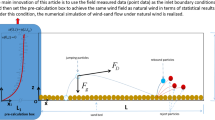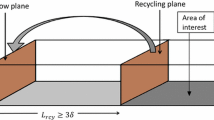Abstract
The micro-scale prediction of sand trapping or take-off over hilly terrains is a crucial issue in semi-arid regions for soil depletion. In this context, large eddy simulations around one or several hills are performed in order to provide statistical parameters to characterize the flow at micro-scales and provide data for mesoscale modelling. We focus on the determination of recirculation zones since they play an important role in solid particle erosion or entrapment. A new wall modeling adapted from Huang et al. (J Turbul 17:1–24, 2016) for rough boundary layers is found to improve the prediction of the recirculation zone length downstream of an isolated hill and is used for all the numerical cases presented here. A geometrical parameterization of the recirculation zones is proposed. When the recirculation region is assumed to have an ellipsoidal shape, the total surface of the recirculation can be obtained from this new parameterization and easily extrapolated to more general dune configurations. Numerical results are compared with experiments performed in our laboratory (Simoëns et al. in Procedia IUTAM 17:110–118, 2015) and good agreement is achieved. We explore general aerodynamic cases deduced from the urban canopy scheme of Oke (Energy Build 11:103–113, 1988). In this scheme the momentum and mass exchange between the upper layer and the space between hills is sorted according to the streamwise hill spacing within three basic cases of skimming, wake or isolated flow. The study of the recirculation zones, the mean velocity and Reynolds stress profiles around an isolated or two consecutive hills with different distances shows that the double hill configuration with 3H separation behaves as much as a whole to the upcoming flow. The vortex formed between the crests does not strongly affect the overall evolution of the outer flow. By an a priori prediction of the preferential zones of erosion and accumulation of fictive particles, it is shown that isolated dunes present more deposition and less erosion than two-hill configurations. The results presented in this study will be discussed in the presence of Lagrangian transport of sand particles above 2D Gaussian hills in future work.
















Similar content being viewed by others
References
Huang G, Simoëns S, Vinkovic I, Le Ribault C, Dupont S, Bergametti G (2016) Law-of-the-wall in a boundary-layer over regularly distributed roughness elements. J Turbul 17:1–24
Simoëns S, Saleh S, Le Ribault C, Belmadi M, Zegadi R, Allag F, Vignon JM, Huang G (2015) Influence of Gaussian hill on concentration of solid particles in suspension inside Turbulent Boundary Layer. Procedia IUTAM 17:110–118
Oke TR (1988) Street design and urban canopy layer climate. Energy Build 11:103–113
Jackson PS, Hunt JCR (1975) Turbulent wind flow over a low hill. Q J R Meteorol Soc 101:929–955
Gong W, Ibbetson A (1989) A wind tunnel study of turbulent flow over model hills. Boundary Layer Meteorol 49:113–148
Cao S, Tamura T (2006) Experimental study on roughness effects on turbulent boundary layer flow over a two-dimensional steep hill. J Wind Eng Ind Aerodyn 94:1–19
Kocurek G, Ewing RC (2005) Aeolian dune field self-organization—implications for the formation of simple versus complex dune-field patterns. Geomorphology 72(1–4):94–105
Cao S, Tamura T (2007) Effects of roughness blocks on atmospheric boundary layer flow over a two-dimensional low hill with/without sudden roughness change. J Wind Eng Ind Aerodyn 95:679–695
Chapman C, Walker IJ, Hesp PA, Bauer BO, Davidson-Arnott RGD, Oller-head J (2013) Reynolds stress and sand transport over a foredune. Earth Surf Process Landforms 38:1735–1747
Almeida GP, Durao DFG, Heitor MV (1993) Wake flows behind two-dimensional model hills. Exp Therm Fluid Sci 7:87–101
Kanda I, Yamao Y, Uehara K, Wakamatsu S (2013) Particle-image velocimetry measurements of separation and re-attachment of airflow over two-dimensional hills with various slope angles and approach-flow characteristics. Boundary Layer Meteorol 148:157–175
Saleh A, Huang G, Vinkovic I, Simoëns S, Le Ribault C, Dupont S, Bergametti G (2014) Concentration of solid particles over hills inside a turbulent boundary layer. Eighth international conference on aeolian research (ICAR VIII), LanZhou, China
Tamura T, Cao S, Okuno A (2007) LES study of the turbulent boundary-layer over a smooth and a rough 2d hill model. Flow Turbul Combust 79:405–432
Cao S, Wang T, Ge Y, Tamura Y (2012) Numerical study on turbulent boundary layers over two-dimensional hills - Effects of surface roughness and slope. J Wind Eng Ind Aerodyn 104–106:342–349
Araújo AD, Partelli EJR, Pöschel T, Andrade JS, Herrman HJ (2013) Numerical modeling of the wind over a tranverse dune. Nat Sci Rep 3:2858
Herrmann H, Andradejr J, Schatz V, Sauermann G, Parteli E (2005) Calculation of the separation streamlines of barchans and transverse dunes. Phys A 357:44–49
Schatz Volker, Herrmann HJ (2006) Flow separation in the lee side of transverse dunes: a numerical investigation. Geomorphology 81:207–216
Hesp PA, Smyth TA (2017) Nebkha flow dynamics and shadow dune formation. Geomorphology 282:27–38
Smyth TA (2016) A review of Computational Fluid Dynamics (CFD) airflow modelling over aeolian landforms. Aeolian Res 22:153–164
Hamed AM, Kamdar A, Castillo L, Chamorro LP (2015) Turbulent boundary layer over 2D and 3D large-scale wavy walls. Phys Fluids 27(10):106601-1-14
Grimmond C, Oke TR (1999) Aerodynamics properties of urban areas derived from analysis of surface form. J Appl Meteorol 38:1262–1292
Vinçont JY, Simoëns S, Ayrault M, Wallace JM (2000) Passive scalar dispersion in a turbulent boundary layer from a line source at the wall and down stream of an obstacle. J Fluid Mech 424:127–167
Simoëns S, Ayrault M, Wallace J (2007) The flow across a street canyon of variable width—part 1: kinematic description. Atmos Environ 41:9002–9017
Simoëns S, Wallace JM (2008) The flow across a street canyon of variable width—part 2: scalar dispersion for the flow across a street canyon of variable width. Atmos Environ 42(10):2489–2503
Blackman K, Perret L, Savory E (2015) Effect of upstream flow regime on street canyon flow mean turbulence statistics. Environ Fluid Mech 15:823–849
Garbero V, Salizzoni P, Soulhac L, Mejean P (2011) Measurements and CFD simulations of flow and dispersion in urban geometries. Int J Environ Pollut 44:288–297
Hussain M, Lee BE (1980) A wind tunnel study of the mean pressure forces acting on large groups of low-rise buildings. J Wind Eng Ind Aerodyn 6:207–225
Shao Y (2009) Physics and modeling of wind erosion, vol 37. Atmospheric and oceanographic sciences library. Springer, Dordrecht
Vinkovic I, Aguirre C, Simoëns S (2006) Large eddy simulation and Lagrangian stochastic modeling of passive scalar dispersion in a turbulent boundary layer. J Turbul 7:30
Tamura T, Cao S (2002) Numerical study of unsteady wake flows over a hill for the oncoming boundary-layer turbulence. Eng Turbul Model Exp 5:237–246 Elsevier
Xue M, Droegemeier K, Wong V, Shapiro A, Brewster K (1995) ARPS version 4.0 Users Guide
Calmet I, Mestayer P (2015) Study of the thermal boundary layer during sea-breeze events in the complex coastal area of Marseille. Theor Appl Climatol 123(3):801–826
Vinkovic I, Aguirre C, Simoëns S, Ayrault M (2006) Large eddy simulation of the dispersion of solid particles in a turbulent boundary layer. Boundary Layer Meteor 121:283–311
Dupont S, Bergametti G, Marticorena B, Simoëns S (2013) Modeling saltation intermittency. J Geophys Res Atmos 118:7109–7128
Le Ribault C, Vignon JM, Simoëns S (2014) LES/Lagrangian modelling for the dispersion of reactive species behind an obstacle in a turbulent boundary layer. JP J Heat Mass transf 9(1):21–55
Dupont S, Bergametti G, Simoëns S (2014) Modeling aeolian erosion in presence of vegetation. J Geophys Res Earth Surf 119(2):168–187
Mott R, Lehning M (2010) Meteorological modelling of very-high resolution wind fields and snow deposition for mountains. J Hydrometeorol 11:934–949
Yoshizawa A, Horiuti K (1995) A statistically-derived subgrid-scale kinetic models for large eddy simulation of turbulent. J Phys Soc Jpn 54(8):2834–2839
Lund T, Wu X, Squires K (1998) Generation of turbulent inflow data for spatially developing boundary layer simulations. J Comput Phys 140:233–258
Aguirre C, Brizuela AB, Vinkovic I, Simoëns S (2006) A subgrid Lagrangian stochastic model for turbulent passive and reactive scalar dispersion. Heat Fluid Flow 27:627–635
Businger JA, Wyngaard JC, Izumi Y, Bradley EF (1971) Flux-profile relationships in the atmospheric surface layer. J Atmos Sci 28:181–189
Huang G (2015) Numerical simulation of solid particle transport in atmospheric boundary-layer over obstacles, Phd thesis, Ecole Centrale de Lyon
Mollinger AM, Nieuwstadt FTM (1996) Measurement of the lift force on a particle fixed to the wall in the viscous sublayer of a fully developed turbulent boundary layer. J Fluid Mech 316:285–306
Schmeeckle MW, Nelson JM, Shreve RL (2007) Forces on stationary particles in near-bed turbulent flows. J Geophys Res Earth Surf 112:F02003
Sumer BM, Chua L, Cheng NS (2003) Influence of turbulence on bed load sediment transport. J Hydraul Eng 129:585–596
Dwivedi A, Melville B, Shamseldin AY (2010) Hydrodynamic forces generated on a spherical sediment particle during entrainment. J Hydraul Eng 136:756–769
Hofland B, Batjes JA, Booij R (2005) Measurement of fluctuating pressures on coarse bed material. J Hydraul Eng 131(9):770–781
Wallace JM, Eckelmann H, Brodkey RS (1972) Structure of the Reynolds stress near the wall. J Fluid Mech 54:6592
Wiggs GGS, Weaver CM (2012) Turbulent flow structures and aeolian sediment transport over a barchan sand dune. Geophys Res Lett 39:L05404
Zimon AD (1969) Adhesion of dust and powder. Springer, Berlin
Acknowledgements
We acknowledge NFSC/ANR Chinese/French program PEDO-COTESOF. This work was granted access to the HPC resources of CINES. Numerical simulations were also performed on the P2CHPD parallel cluster.
Author information
Authors and Affiliations
Corresponding author
Rights and permissions
About this article
Cite this article
Huang, G., Le Ribault, C., Vinkovic, I. et al. Part I : a priori study of erosion and deposition with large eddy simulation of turbulent flow over multiple 2D sandy Gaussian hills. Environ Fluid Mech 18, 581–609 (2018). https://doi.org/10.1007/s10652-017-9552-x
Received:
Accepted:
Published:
Issue Date:
DOI: https://doi.org/10.1007/s10652-017-9552-x




